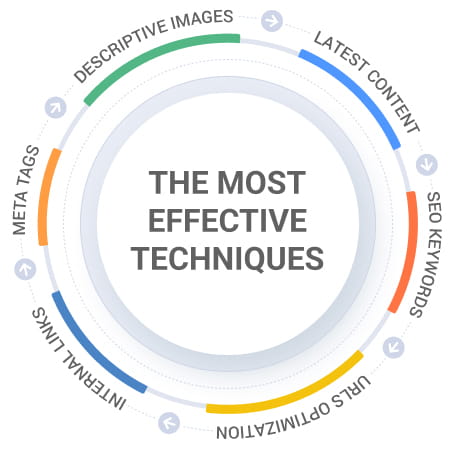
In the ever-evolving landscape of digital marketing, Search Engine Optimization (SEO) remains a cornerstone for businesses aiming to increase their online visibility and attract qualified traffic. SEO encompasses a wide range of strategies, broadly categorized into on-site and off-site efforts. While off-site SEO (like link building and brand mentions) builds authority from external sources, it's on-site optimization in seo – the adjustments made directly on your website – that lays the critical foundation.
Think of your website as your digital storefront. On-site optimization is akin to ensuring the store is well-organized, clearly labeled, easy to navigate, and stocked with high-quality products (content) that customers are looking for. Without this solid internal structure and optimization, even the best off-site promotion efforts will fall short.
This guide provides a deep dive into on-site optimization in seo (also known as on-page SEO), covering the essential elements and best practices businesses need to implement in 2025 to improve their search engine rankings, enhance user experience, and ultimately drive growth.
Why is Onsite Optimization Crucial for Your Business?
Effective onsite optimization is non-negotiable for several key reasons:
- Search Engine Understanding: It helps search engines like Google crawl, interpret, and understand what your content is about, indexing it correctly for relevant search queries.
- Improved User Experience (UX): Many onsite factors, such as site speed, mobile-friendliness, clear navigation, and readable content, directly impact how users interact with your site. Positive UX signals are increasingly important ranking factors.
- Increased Relevance: Optimizing pages around specific keywords and user intent makes your content more relevant to search queries, improving your chances of ranking.
- Higher Click-Through Rates (CTR): Well-crafted title tags and meta descriptions visible in search results entice users to click on your link over competitors.
- Enhanced Authority & Trust: A well-structured, fast-loading, secure website with high-quality content signals trustworthiness and authority to both users and search engines (contributing to E-E-A-T: Experience, Expertise, Authoritativeness, Trustworthiness).
- Foundation for Off-Site SEO: High-quality, optimized content provides valuable assets for link-building and social sharing efforts to target.
Key Elements & Best Practices for Onsite Optimization in SEO
Mastering onsite optimization in seo involves paying close attention to various elements within your website's pages and overall structure. Here are the critical areas and best practices for 2025:
- Strategic Keyword Research & Integration:
- Understand Search Intent: Before targeting keywords, understand why users are searching. Are they looking for information (informational), trying to find a specific website (navigational), ready to buy (transactional), or researching before buying (commercial)? Tailor content and keywords accordingly.
- Identify Target Keywords: Use keyword research methods (analyzing competitors, using Google Suggest, exploring online forums, leveraging keyword tools) to find relevant terms your audience uses. Focus on primary keywords, secondary (semantically related or LSI) keywords, and specific long-tail keywords.
- Best Practices: Integrate keywords naturally within your content. Don't force them unnaturally (keyword stuffing penalties are real). Place your primary keyword strategically in your title tag (ideally near the beginning), H1 heading, the introductory paragraph, and naturally throughout the body text, subheadings, image alt text, and URL where appropriate. Focus on topic relevance and covering the subject comprehensively.
- High-Quality, Relevant Content:
- Content is Foundational: Your content must provide real value, answer user questions thoroughly, and be engaging. Unique, high-quality content is arguably the single most important ranking factor.
- E-E-A-T: Ensure your content demonstrates Experience, Expertise, Authoritativeness, and Trustworthiness, especially for "Your Money or Your Life" (YMYL) topics.
- Best Practices: Create comprehensive content that fully addresses the search intent behind your target keywords. Structure content logically using headings and subheadings (H2-H6). Use short paragraphs, bullet points, and clear language for better readability. Keep content updated and fresh. Ensure absolute originality – avoid duplicate content issues. Use multimedia like images and videos to enhance engagement.
- Optimized Title Tags (
<title>):
- The SERP Headline: This HTML tag defines the title of your page, appearing in browser tabs and as the main clickable headline in search results. It's a critical ranking signal.
- Best Practices: Create a unique, descriptive title tag for every important page. Include your primary keyword, preferably near the beginning ("front-load"). Keep the length around 50-60 characters to prevent truncation in SERPs. Write compelling copy that accurately reflects the page content and encourages clicks.
- Compelling Meta Descriptions (
<meta name="description">):
- The SERP Snippet: This brief description appears below the title tag in search results. While not a direct heavy ranking factor itself, it significantly impacts whether users click on your result (CTR).
- Best Practices: Write unique, engaging descriptions that act like ad copy for your page. Clearly summarize the page's content and include relevant keywords naturally. Keep it concise, ideally under 160 characters, to avoid being cut off. Include a call to action if appropriate.
- Structured Header Tags (H1-H6):
- Content Hierarchy: Header tags (H1, H2, H3, etc.) structure your content logically, making it easier for both users and search engines to scan and understand the page's key topics.
- Best Practices: Use only one H1 tag per page, typically containing the main topic or primary keyword (often similar to the title tag). Use H2 tags for main sections, H3s for sub-sections, and so on, in a logical hierarchy. Incorporate keywords and variations naturally within headings to signal relevance, but avoid stuffing.
- SEO-Friendly URL Structure:
- Web Addresses: The URL is the address of your webpage.
- Best Practices: Create short, descriptive URLs that are easy for users and search engines to understand. Include the primary keyword if relevant and natural. Use hyphens (
-) to separate words (not underscores_). Use lowercase letters. Maintain a clear, logical folder structure if applicable (e.g., yourdomain.com/services/on-site-seo).
- Image Optimization:
- Visual SEO: Images enhance content but need optimization.
- Best Practices:
- Descriptive File Names: Use names like
onsite-seo-best-practices.jpginstead ofDCIM1001.jpg. - Alt Text: Write descriptive alt text for every image. This helps visually impaired users (screen readers) and tells search engines what the image is about. Include relevant keywords naturally.
- Compression: Compress images to reduce file size (using tools or formats like WebP) for faster page loading, balancing quality and performance.
- Dimensions: Use images sized appropriately for their placement on the page.
- Strategic Internal Linking:
- Connecting Your Content: Internal links connect one page on your website to another page on the same site.
- Best Practices: Link relevant pages together using descriptive anchor text (the clickable words). This helps users navigate your site, distributes link equity (ranking power) throughout your pages, and helps search engines understand the relationship and context between different pieces of content. Aim for natural, helpful links.
- Technical On-Site Foundations:
- Page Speed & Core Web Vitals: How fast your page loads and responds is crucial for UX and rankings. Optimize images, minify CSS/JavaScript, leverage browser caching, use fast hosting, and consider a Content Delivery Network (CDN). Google's Core Web Vitals (LCP, INP, CLS) are key metrics.
- Mobile-Friendliness (Responsive Design): Your website must work flawlessly on all devices (desktops, tablets, smartphones). Google primarily uses the mobile version of your site for indexing and ranking (mobile-first indexing).
- Logical Site Architecture: A clear, intuitive website structure makes it easy for users to find information and for search engines to crawl and index effectively. Use clear navigation menus and consider breadcrumbs.
- Schema Markup (Structured Data): Implement structured data markup (e.g., using Schema.org vocabulary) to provide explicit context about your content to search engines. This can result in "rich snippets" (like star ratings, prices, event dates) appearing in SERPs, improving visibility and CTR.
- XML Sitemap: Create and submit an XML sitemap (a list of your important URLs) via Google Search Console to help search engines discover your content efficiently.
- Robots.txt: Use this file to tell search engine crawlers which parts of your site they should not crawl or index (e.g., private admin areas, duplicate content intended for internal use).
- HTTPS Security: Ensure your entire website uses HTTPS (SSL/TLS certificate). It's a ranking signal, builds user trust, and encrypts data exchanged between the user and your server.
Tools for Onsite Optimization
While expertise is key, certain tools are essential:
- Google Search Console: Indispensable for monitoring site health, indexing status, mobile usability, Core Web Vitals, security issues, and understanding how Google sees your site.
- Google Analytics: Tracks website traffic, user behavior, content performance, and goal conversions.
- Page Speed Tools: Tools like Google PageSpeed Insights help analyze loading performance and provide optimization suggestions.
- Keyword Research Tools: Help identify search terms, volume, and competition.
- SEO Plugins (for CMS): Platforms like WordPress have plugins (e.g., Yoast SEO, Rank Math, AIOSEO) that assist with many on-site tasks like managing titles, descriptions, and sitemaps.
Onsite SEO: A Continuous Improvement Process
On-site optimization in seo is not a one-off project. It requires ongoing attention because:
- Search engine algorithms constantly evolve.
- Competitors are always working to improve their rankings.
- User search behavior and expectations change.
- Your own business goals and content strategy may shift.
Regularly monitor your site's performance using analytics and Search Console, conduct periodic SEO audits, update existing content, and refine your strategies based on data.
Webxloo: Your Partner for Effective Onsite Optimization
Implementing a comprehensive onsite optimization in seo strategy requires a deep understanding of search engine guidelines, technical expertise, high-quality content creation skills, and consistent effort. Juggling all these elements can be challenging for busy business owners.
This is where partnering with specialists can provide a significant advantage. Webxloo offers expert On-Site SEO services designed to meticulously optimize every critical element of your website. Our team delves into:
- In-depth keyword research tailored to your niche and audience.
- Crafting and refining high-quality, engaging, E-E-A-T compliant content.
- Optimizing crucial HTML elements like title tags, meta descriptions, and header tags.
- Enhancing URL structures and implementing strategic internal linking.
- Comprehensive image optimization.
- Addressing technical SEO factors, including site speed, mobile-friendliness, and schema markup.
- Ensuring your website architecture supports both user experience and search engine crawling.
We work to ensure all on-site factors are aligned to maximize your search engine visibility, attract more qualified organic traffic, and improve user engagement.
Conclusion: Building Your Foundation for Search Success
On-site optimization in seo is the bedrock upon which successful search engine visibility is built. By focusing on creating high-quality content that genuinely serves user intent, ensuring your website is technically sound and performs well, and meticulously optimizing individual page elements, you create a powerful signal to search engines that your site deserves to rank.
Remember, the goal is twofold: make your website easily understandable and valuable for search engine crawlers, and provide a seamless, satisfying experience for your human visitors. Consistent effort in on-site optimization in seo, potentially guided by experienced professionals like Webxloo, translates directly into better rankings, more targeted organic traffic, increased credibility, and ultimately, sustainable business growth.




 Phone Consultation
Phone Consultation
 Request a quote
Request a quote
 Text a Message
Text a Message